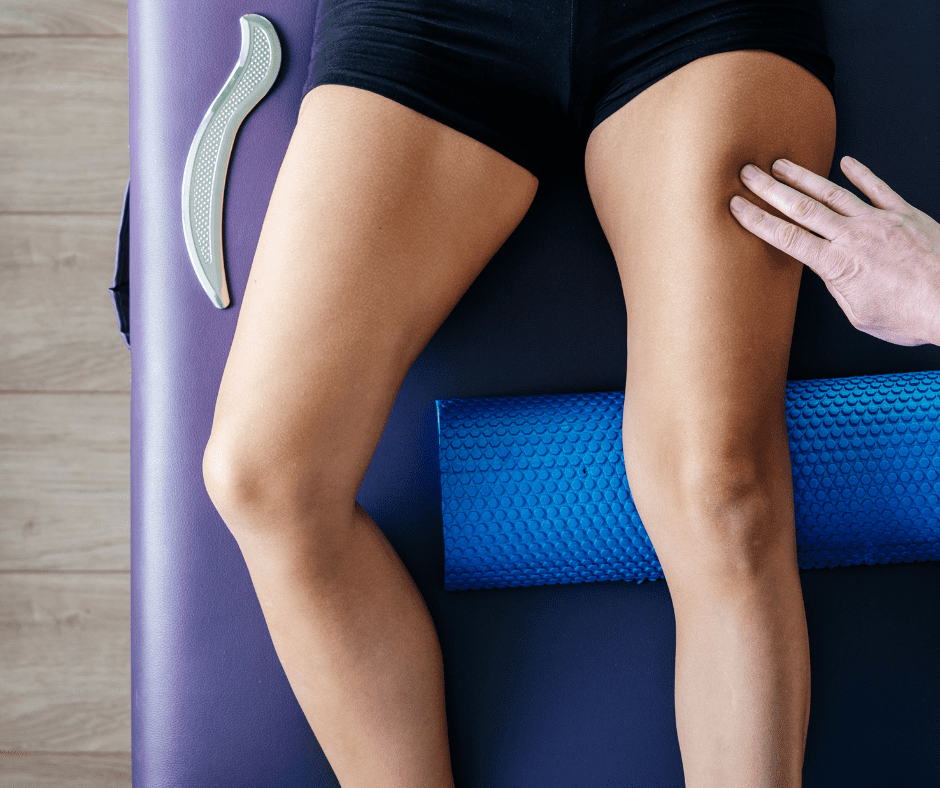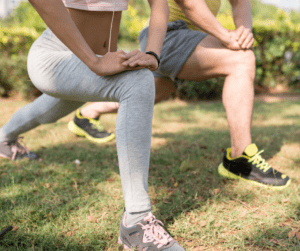A lot of us know the quadriceps femoris muscles, as our “quads” muscle.
Running, skipping, squatting, and jumping… To do any of these activities you need a strong set of quadriceps.
Your quadriceps are located in the anterior compartment of your thigh, together with the sartorius muscle, which is a long, narrow muscle running obliquely across the front of each thigh.
Let’s have a look at learning more about our quadriceps, how they work, what can cause tightness in our quads, how you can release tight quads, and how you can strengthen them….

What Causes Tight Quadriceps?
Firstly, it’s quite important to know that your quadriceps femoris is one of the largest and strongest muscles in your body. Each quad is a group of four muscles located at the front of your thigh.
We rely a lot on our quads to do many forms of physical activity, especially running. Therefore they can be prone to injury quite easily.
Those four muscles are primarily responsible for hip flexion and extension at the knee joint, they all attach near your kneecap.
The primary function of your quadriceps is to extend (straighten) your knee.
Let’s have a quick overview of each of those four muscles…
- Rectus Femoris
- Vastus Lateralis
- Vastus Medialis
- Vastus Intermedius
Rectus Femoris
The rectus femoris is responsible for stabilizing and creating flexion at the hip joint. It is the only muscle in the quadriceps group that crosses the hip.
Vastus Lateralis
This muscle is the largest of the quadriceps muscles. In elite athletes, you can actually see this muscle quite prominently on the outside of their thighs. The Vastus Lateralis aids in extending your knee.
Vastus Medialis
This muscle is shaped like a teardrop and runs along the inside of the front of your thigh. It works with the other three muscles to extend the knee as well as stabilize the kneecap. Very often, in runners, this is where there is a weakness and can cause knee issues.
Vastus Intermedius
The Vastus Intermedius muscle lies underneath the other three muscles. The primary function of this muscle is knee extension.
Now that we know a bit more about our quads, let’s have a look at why they get so tight sometimes…
It might make you feel better to know that tight quadriceps are very common. They can be caused by overuse and underuse.
The problem that comes with tight quads is that they could lead to pain in other parts of your body.
For example, if left untreated, tight quads could lead to postural imbalances and contribute to pain in your lower back because they pull your pelvis down as well as weak hamstring muscles and pain in your hips and knees… very often tightness in muscles is accompanied with weakness too.

This Is Why Your Quads Always Feel Tight
If you have increased your physical activity recently or if you sit for hours without much movement then your quads will feel tight.
By sitting at your desk all day you reduce the amount of time you spend lengthening and shortening those four muscles we chatted about earlier… therefore those muscles become more resistant to stretching or lengthening as tightness is very often accompanied by a weakness in strength.
The Reasons For Your Tight Quads Can Be Summed Down To:
- Overtraining/ overuse
- Lack of movement/ underuse
- Dehydration (Muscles need water to function optimally)
- Tightness in another area of your body (Causing you to modify your posture)
- Certain prescribed medicines can cause muscle stiffness.
If you’re a runner or lead a fairly active lifestyle, or not at all and sit at your desk for most of the day… then chances are very high you’ve had tight quads. This is how you can tell if you’ve got tight quads.
Tight Quad Symptoms
- Pain and swelling in your thighs
- Visible inflammation (In extreme cases)
- Difficulty bending or straightening your knee
- Pain in your lower back
- Trouble with your hips or tight hip flexor muscle
- Knee issues, such as finding it difficult to bend or straighten the knee without pain or discomfort
- Weakness in your leg and reduced range of motion
- Sharp pain when running
As powerful as our quads are… we now know they are vulnerable to injuries if they are neglected…
Let’s have a look at ways we can prevent getting tight quads in the first place.
How To Prevent Getting Tight Quadriceps
- Warming up properly before any activity.
By warming up you’re trying to kick-start the physiology which is delivering energy to the working muscles and to get the body – in the true sense of the word – warm.
By heating the muscles up they then slide over each other much more easily thereby reducing the risk of injury.
A 5-minute walk or a very very very easy jog early on in the run – even when you’re doing an easy training run – goes a long way.
Here’s an experiment to do on yourself… if you start running very very easy (don’t worry about pace).
Let me use myself as an example, my typical training run is between 5:30 and 6:00 per kilometre – and regardless of what intensity run I’m doing, I will typically start somewhere in the region of 6:30 per kilometre.
I don’t look at my watch. I just start very easy. Within about 5 minutes of exercise, I find myself with not much increase in effort and easily run at my training pace. On those runs when I do that I typically end up running very comfortably at 4:30 and 4:40 per kilometre with very little effort.
On the converse side, If I start out much harder or much closer to your average pace. On those same runs I would start out at 5:30, sometimes when I run with my friends they like to start out quite hard, and I will literally feel like I’m pushing through the whole run just to maintain that pace because I haven’t given my body a chance to adapt to what I am about to do.
- Cool down after your activity.
Cooling down allows your body temperature, blood pressure, and heart rate to return to their normal levels.
This can be in the form of an easy cool-down walk, light stretch or foam roll. Find out what works for you
We recommend doing dynamic stretches before you run and static stretches after your run, this contributes to blood flow and range of motion.
5 Things To Avoid Doing After Running: Stop Doing This If You Want To Become A Better Runner
- Strength training.
Strengthening your quads, hamstrings, and hip flexors can also help reduce your risk of injury. Stronger muscles also provide more support to your joints during your activity.

Eccentric quad exercises are really important to avoid injury as well as prevent muscle soreness after hard running and downhill running. Every time you push off in running your quads contract concentrically.
Every time you land on the ground, quads contract eccentrically (acts as a shock absorber) it is here where you get most of the muscle damage. By training quads eccentrically we can reduce the amount of muscle fibre damage done in eccentric contractions
We will get to specific quadriceps strength training exercises further on in this article…
Making sure you do the correct strength training is important. The good news is we’ve created a free strength training plan for runners that you can download by clicking here.
We should first have a look at ways you can release your tight quads.
How To Release Tight Quadriceps
- Stretch Those Quads Out
The ends of your quadriceps are at your knees and your hips, this is why tight quads can result in knee pain or even lower back pain…
A few minutes of stretching can save you from those unwanted tight quads, we recommend dynamic stretching before your exercise snd then some static stretching after your exercise, during your cool down.
Although, Just a few mins of stretching post-run is not going to make a massive difference. This needs to be a focused aspect if one is going to do static stretching. ie. need to set aside some time every day to do some static stretching.
Mobility work is key as then we are improving the flexibility around several joints and not just one muscle (ie. the hip girdle and the knee as opposed to just stretching the quadricep),
- Foam Roll
Foam rolling exercises release tension in the body’s tight spots and muscle tissue to prevent injury, support athletic performance, and increase the quality of soft tissue.
If you’re experiencing pain in your quads as a result of an injury, do not roll directly on the injured spot. Instead, roll away from the pain point to work the connecting muscles.

- Balance on your elbows in a plank position with your quadriceps on the foam roller.
- Brace your core and avoid arching or rounding your lumbar spine.
- Roll from just above the kneecaps to the top of the thighs.
Perform 1–2 sets of 30–90 seconds before or after exercising.
Let’s have a look at those stretches we mentioned earlier…
Quadriceps Stretches
Note: Stretching is important but mobility is key and strength training is vital… without strength training, stretching is very often useless.
If mobility is something you struggle with, then grab our free mobility flow that you can do at home by clicking here.
- Kneeling stretch
- Kneel on your right knee and put your left leg out in front of you at a 90-degree angle (As if you were proposing to someone) and curve your pelvis under.
- Flatten out your lower back and keep your shoulders and chest upright.
- Bend forward from the hip to your knee even more to stretch the right hip and quad.
- Hold for 30 seconds and then switch knees.
- Standing quad stretch
- Begin standing, with your left hand holding onto a stable object for support.
- Grab your right ankle with your right hand and draw your foot towards your buttocks without arching your low back.
- Hold for 30 seconds and then switch legs.
- Side-Lying Stretch
- Lie down on your side on an exercise mat or towel.
- Bring your ankle to your buttocks while bringing your arm back and holding on to your foot.
- Gently bring your foot into your buttocks, feeling the stretch in the front of your thighs.
- Hold for 30 seconds and then repeat on the other side and leg.
Note: These stretches are meant to be gentle and if any pain is felt while holding them then you should refrain from holding them for the full 30 seconds.

Quadriceps Strength Exercises
You should be doing eccentric exercises to help strengthen your quads.
Eccentric exercises are slow, lengthening muscle contractions that are for a specific muscle, in this case, your quads.
An example of an eccentric exercise that you could do is Single Leg Step Down.
- Start by standing with one foot on a step, and one foot off the ground.
- Slowly lower the unaffected leg down off the side of the step. Lightly touch your heel to the floor.
- Return to the original position.
- Repeat until the number of reps is completed.
- The Switch legs.
Here at Coach Parry, we’re massive advocates of strength training. We’ve put together this free strength training plan for runners that you can do once a week, at home and with no expensive equipment needed. You can access it by clicking here.




Comments are closed.